We’ve been tracking the path of the sun for the past three weeks in Central Virginia. I shared my notes on what we used for a sundial a few days ago and the path of the sun for various days leading up to the “equinox”.
For the past few days we have not had any clear sun to go by, but today (3/20/14) it was clear from the moment the sun rose above the horizon. So I began making my marks (black dots in the picture below).
I expected the line to be straight until mid-day, given what I’ve seen in the past. Then, typically around what I believe to be solar noon the line bends. So, I waited until late in the morning to connect the dots.
I used a straight edge to connect the dots, making sure the line included every mark I made. The marks were made about 20 minutes apart, with some more or less often. I was kind of expecting it to bow during mid-day, so when I aligned our straight edge to the (solar) noon-time markings and saw that it remained straight, I was surprised.
By this time I had called my husband over and he was surprised as well. So I continued to make my marks through the afternoon and sure enough, the line stayed straight.
You may wonder why I was surprised. We are at 37.87 degrees N latitude, so I expected the straight line to have appeared at least a day earlier than the “equinox” as calculated by NASA.
We did not make any alterations to our gnomon (the screw that cast the shadows on our table) in consideration for our latitude. We just affixed a screw to the table (it may even be slightly crooked).
We were just measuring the tip, so we didn’t think it mattered provided it was a fixed point. But I thought we were far enough north on the land to warrant a difference between the calculated equinox day and the day when the sun rises and sets due east and due west, respectively in our latitude.
I guess not.



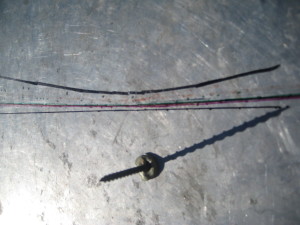
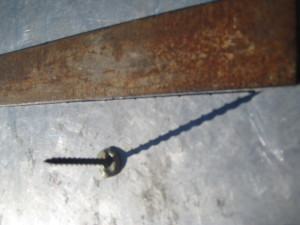
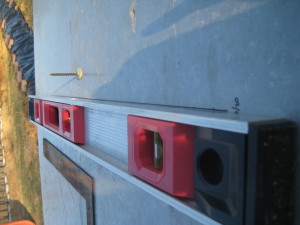
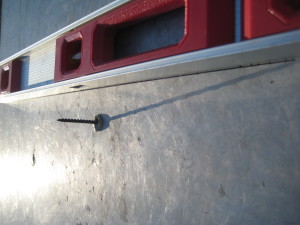
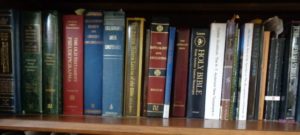
Pingback: Watching the Path of the Sun | Messyanic Misfits
Pingback: The Day After…the Spring Equinox | Messyanic Misfits
Do you use the equinox at the equator or Jerusalem for your calendar? . If you are using Jerusalem, or any latitude (such as central Virginia), then you need to bend the nail on the sundial to where the angle of the nail on the sundial disk and the sundial disk equals the latitude you are at or trying to determine. This is shown in the following article
http://solar.physics.montana.edu/cgi-bin/advanlesson.cgi
The equinox at the equator is on March 20th and the New Year would be on the 21st, but if you are using Jerusalem the equinox would be earlier as it should have been in Central Virginia with the nail bent for that latitude. If using Jerusalem, the equinox was on March 16th and the New Year on the 17th as seen on the timetable below
http://www.timeanddate.com/worldclock/astronomy.html?n=110&month=3&year=2014&obj=sun&afl=-11&day=1
As you can see from the above timetable the equinox in March 16th and the first day when the day starts getting longer is the 17th.
I was just curious because my wife and I are trying to keep the calendar based on the equinox. You might remember my wife, Bonnie, giving away Feast of the Lord DVD’s on bpearthwatch’s radio show. A little bit about myself, I am a PhD Candidate in Physics with a Master’s in Physics. So you know I am curious about everything:). I appreciate all the Research you and you friends have done on the calendar. My wife and I used one very similar, well almost exactly:) but I like the term Marker Day and I liked how your friend showed from the scriptures how the Sabbaths fell. I am also a friend of yours on Facebook.
If you have any questions or comments, feel free to email me
God Bless
Greg
Hi Greg,
Thanks for commenting. I thought I recognized your name. 😉
The link you gave above suggests putting the gnomon at an angle so that you can tell what hour (based on 60 minutes, I believe) of the day it is at the equator. That is measured by looking at the *line shadow* cast by the bent nail.
However, we weren’t interested in determining the time on the clock. Instead we were simply trying to see the path the sun takes across the sky to see if any patterns emerged. That is why we were just measuring the *shadow of the tip* of a screw (a fixed point).
We noticed a few weeks ago that there were symmetrical arcs created with the path of the sun over the course of a day. As time passed the arcs were flattening. We figured that once the arc was completely flat, that was likely a “marker day” and it would also tell us the directions of due east and due west.
We were kind of expecting it to be straight at least a day or two before the equinox because we are at a higher latitude than the equinox. That is why we were surprised when we saw that it was straight on March 20th.
Jerusalem is at a latitude north of the equator but south of us. So if the line was straight here in Virginia as well as on the equator, then it would have been straight in Jerusalem as well.
Last year we didn’t know how to determine the “marker day”. We had assumed the primary factor was “equal day & equal night”, so we went to timeanddate.com and looked at the “hours” (in minutes and seconds) for Jerusalem. We saw that the “day” was as close to 12 hours as it was going to get on March 16, 2013. We also saw someone in a youtube video from CO with an instrument set up pointing to the North star demonstrate that the sun traveled in a straight line on that particular day, so we took that as confirmation.
But over the course of the year, I began to seriously doubt our methods. For one, how would we know what equal day and night was in Jerusalem if we did not have the internet? Also, who determines the start and end to the day? I personally believe the day begins *before* we see the sun pop over the horizon, simply because the sky is light before then. (The same goes for the end of the day and the sun slipping below the horizon. The sky still has some light in it before it is completely dark.) So measuring the length of a day seemed impossible to me…it is too subjective.
I was intrigued by the instrument used on Youtube, and my husband and I were seeking to come up with a way for us to witness the sun’s path for ourselves.
My husband had theorized that it was possible the sun’s path would be a straight line on the “equinox” day, not just at the equator but over most of the globe, given that it was so far away. (I’ll ask him to do a video or something to explain that concept better.)
We talked and talked about it, but figured the only way we would know anything was to conduct our own experiments. Hence our sundial table experiment. 😉
We’re still observing the path of the sun, and we expect there will be another interruption to the pattern that is emerging now (the line arcing in the opposite direction). When the sun reaches furthest north at solar noon it seems to us that will be another “marker day”.
Do you still measure each year? Last year (2017) was our first year measuring and watching the shadows- we did it all year long and are looking for others who do the same for 2018.
https://www.youtube.com/watch?v=dz3NxgpiJDg
We haven’t measured it for ourselves in the past several years, and we just took down our sundial table last year to expand our garden. We have no plans to replace it at this time because we have so many other projects on our plate at the moment, but I think it is definitely a worthwhile project for all to do, just to see what the sun is doing throughout the day, and year.
I like your “Project Shadow Watch” idea and the video is a great commercial for it. Personally, though, I don’t believe the earth is a globe. Nonetheless, I think it’s a great idea to encourage folks all across the land to pay attention to what the sun, as well as the moon and stars, are doing up above. 🙂
Actually bending the nail is to determine the equinox at a latitude other than zero(the eequator). The angle between the bent nail and the disk should equal the latitude you are trying to determine the equinox for. For instance, if you are at 30 degrees then the angle between the nail and the disk should be 30 degrees. Then as the Sun moves across the sky, you mark where the shadow is until you have a straight line. It should happen earlier at 30 degrees than at zero degrees. That is why the equinox for Jerusalem fell on the 16th instead of the 20th for equator. Bonnie and I were just confused which date to use as Marker day. Thanks for reading my comments.
Greg
It seems to me that we ought to be able to observe the times without having to know the latitude of our position on the earth.
I believe if one were to simply put a staff (of any length) in the ground (at any angle) in an area that gets full sun and measures the shadow of the tip of the staff, he/she should be able to tell the the time of day (morning vs. afternoon/evening) as well as the time of year, no matter where he/she is within the temperate regions on the earth.
you only have to set the angle if you are using an armillary type instrument. Isha- you are right.. a pole, staff, nail or I use a stovepipe will give you straight lines at the equinox. It did for us in UTAH!
Thanks for the witness of your result in Utah!
I could be wrong, so I will check which sundial link I sent you, I could’ve sent the wrong link. It has been awhile since i played with sundials, but i remember you had to do somthing to take in account the latitude, but would the people in Jerusalem at that time know to do it?. Thanks
Greg
Pingback: Sun Gives Signs to Mark | Messyanic Misfits